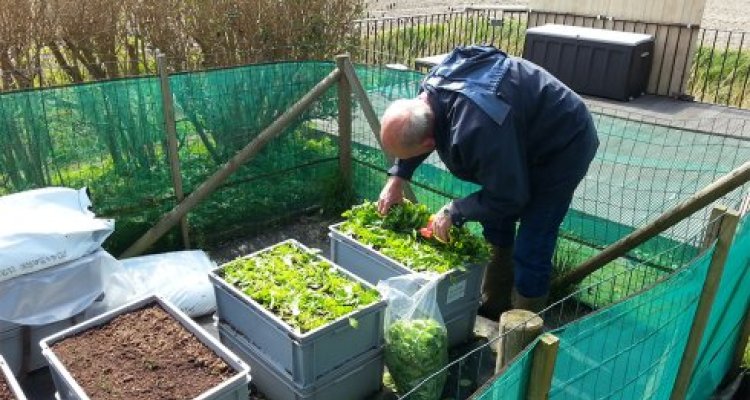
10 questions on biomonitoring - plants that measure air quality
Biomonitoring is the use of plants to measure air quality. Plants can absorb and store substances from the air. After harvesting, these can be analysed for compounds such as heavy metals, PAHs, dioxins and PCBs. Biomonitoring has been found to be a powerful tool for monitoring air quality around waste incineration plants, ore-processing industries and airports.
1. What is biomonitoring?
In order to measure air quality using biomonitoring, WUR researchers grow sensitive plants such as spinach, kale and grass in the vicinity of industries with airborne emissions (the ‘source’). These plants are grown as indicator plants. They can absorb and store substances from the air, usually without visible symptoms. The plants are grown in containers with standardised soil to exclude any influence of local differences in soil quality and to limit measurements to airborne absorption. As an additional measure, milk samples are sometimes taken from dairy farms in the vicinity of industrial sites.

Every four weeks, the researchers examine whether the plants are showing abnormalities and look for the presence of any harmful compounds such as heavy metals, PAHs, fluorides and dioxins in the plants. If abnormalities do occur, this becomes apparent at an early stage. The measurements mainly have a signal function. As long as the standards are not exceeded in the indicator crops and products, all the crops grown in the immediate vicinity of the source are safe. Further investigation is only needed if the norms are exceeded.
2. What kinds of industrial situations is biomonitoring used in?
Biomonitoring can be used to measure air quality around individual point sources such as waste incineration plants, ore-processing industries, power plants and airports. It can also be used in areas with a lot of industry or around large industrial estates. Another use is for monitoring the quality of food crops grown in an urban area.
3. What substances can biomonitoring identify?
The range of compounds that can be included in a biomonitoring programme depends on the emissions being released. Other selection criteria include properties such as toxicity, volatility, demonstrability and societal relevance (such as dioxins in milk).
Monitoring air pollutants such as carbon dioxide (CO2), sulphur dioxide (SO2), particulate matter, ammonia (NH3) and nitrogen oxides (NOx) is less useful since these substances are emitted by many different sources such as industry, agriculture, households and traffic. These components cannot be identified in plants as such because of the conversions that take place in the plant and because it is impossible to distinguish the contribution made by an individual source from the ‘blanket’ that already covers the Netherlands.
4. Where are measurements taken?
As the name suggests, the main function of a biomonitoring programme is to monitor. This requires spatial distribution with measuring points in as many wind directions as possible in relation to the source. It can then be investigated whether there is a correlation between the wind direction and the levels found. The number and location of the monitoring points is determined on the basis of the geographical location of the source and the likely distribution pattern of the emissions. A reference measurement point is also set up at a greater distance from the direct sphere of influence of the source to determine the local background load. Between five and eight measuring points are sufficient for most situations.
5. How often are measurements taken?
A biomonitoring programme can monitor the air quality around an industry all year round. The frequency of sampling depends on the plant species:
- Spinach is grown in spring and summer and is harvested and analysed every four weeks.
- Kale is grown in autumn and winter and is analysed every eight weeks.
- Fluoride levels in grass are determined every four weeks throughout the year.
In order to reliably determine trends over time (whether environmental quality is better, the same or worse than the background load), a multi-year measurement programme is required.
6. Who carries out the biomonitoring?
The monitoring activities, which include setting up the measuring points, growing the crops, harvesting, reporting and discussing the results with the parties concerned, are carried out by WUR employees. The crop analyses are outsourced to external certified laboratories.
7. What are the measurements tested against?
To determine the effects on crops, the measured levels around the source are compared with those at the reference point, which is in the same area but outside the direct sphere of influence of the source (local background levels). The levels are also compared with the national background levels.
8. When are the results available?
After each sampling it takes about three weeks for the analysis results to become available. A measurement programme of at least one year is required to identify trends over time.
9. Who can view the results?
Each biomonitoring programme has a supervisory committee on which the parties involved are represented. The supervisory committee meets once or twice a year to discuss the outcomes of the programme. Potential adjustments to the monitoring programme are also discussed at these meetings. Once the annual report has been drawn up, it is generally made public.
10. What previous projects have there been?
An example of a previous project is the biomonitoring carried out to map the situation around Lelystad Airport. The future consequences of the planned expansion of Lelystad Airport on crops in the immediate vicinity was determined by taking measurements near Bremen Airport, which has similar activity levels to the future Lelystad Airport. This study found that emissions of aircraft exhaust fumes have no adverse impact on the quality of the crops grown in the immediate vicinity of Bremen Airport.